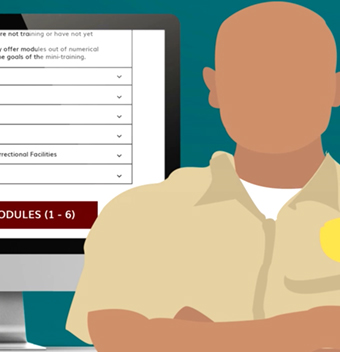Training Modules
Note: Individual training files can be downloaded from the Materials page. Click here to access materials.
Welcome to the Training
1
What is Mental Health?

| Time: | 45 min. |
| Format: | Lecture, Video, Discussion |
| Competencies: | Recognize that wellness includes multiple dimensions, such as emotional, physical, and social health. Describe and compare criteria for defining a mental disorder versus serious mental illness. |
2
Characteristics of Correctional Populations

| Time: | 45 min. |
| Format: | Lecture, Video, Discussion |
| Competencies: | Recognize that incarcerated people disproportionately come from backgrounds of trauma and adversity. Name mental disorders that are common among people who are incarcerated. Identify proportion of incarcerated people who have serious mental illness, substance use disorders, and co-occurring disorders. |
3
De-Institutionalization and Criminalization

| Time: | 90 min. |
| Format: | Lecture, Activity, Discussion |
| Competencies: | Recognize the roles that de-institutionalization and criminalization (e.g., of addiction, homelessness, poverty) play in increasing the number people in correctional institutions who have mental disorders and/or histories of trauma and adversity. |
4
Corrections in the Context of the Justice System

| Time: | 60 min. |
| Format: | Lecture, Activity, Discussion |
| Competencies: | Identify the role of corrections within the broader justice system. Compare criteria for incarceration in a prison versus a jail. Describe corrections' functions of punishment, deterrence, containment, and rehabilitation. Understand the Sequential Intercept Model and how it could improve response to mental health of incarcerated people. |
5
Challenges of Mental Disorders for Incarcerated People

| Time: | 45 min. |
| Format: | Lecture, Video, Discussion |
| Competencies: | Recognize increased problems within institution for people with mental disorders. Describe other aspects of prison that create challenges in responding to people with mental disorders. Describe the consequences of inadequate responses to incarcerated people with mental disorders. Identify concerning behaviors to look for. |
Videos
Video 1: Meet Raymond Smith

Video 2: Malingering

Video 3: Effectively Observing Life in Prison

DOWNLOAD ALL

6
The Subjective Experience of Mental Disorder

| Time: | 30 min. |
| Format: | Lecture, Video, Discussion |
| Competencies: | Understand that the subjective experience of mental disorders may create challenges in daily living. |
7
Maintaining Safety, Offering Respect

| Time: | 45 min. |
| Format: | Discussion, Video, Activity |
| Competencies: | Value one's own role in maintaining the safety of the facility for all involved. Value a compassionate and effective response to mental disorders. |
8
Mental Disorders and Individual Rights

| Time: | 45 min. |
| Format: | Lecture, Video, Discussion |
| Competencies: | Recognize basic signs and symptoms of common mental disorders. Recognize that mental disorders have genetic, environmental, and lifestyle causes. Understand the rights of people with mental illness to treatment and to self-determination, as balanced with the safety needs of the individual and others. |
9
Common Medications and Malingering

| Time: | 30 min. |
| Format: | Lecture, Video, Discussion |
| Competencies: | Recognize common side effects of medications used to treat mental disorders. Describe prevalence and motivations for malingering. Understand the rights of people with mental illness to treatment and to self-determination, as balanced with the safety needs of the individual and others. |
10
Mental Health Screening

| Time: | 45 min. |
| Format: | Lecture, Activity |
| Competencies: | Describe the purpose of mental health screening in corrections. Name a screening instrument that can be administered by correctional officers in prisons and jails. Describe appropriate settings within the facility, appropriate body language, and tone for screening. Describe timing when screening should take place for incarcerated people. Differentiate appropriate and inappropriate use of findings of mental health screens. |
11
Crisis and Mental Illness

| Time: | 30 min. |
| Format: | Lecture, Video, Discussion |
| Competencies: | Describe elements of a crisis. Describe non-verbal techniques for de-escalating a crisis. |
12
The C.A.F. Model

| Time: | 40 min. |
| Format: | Discussion, Video, Activity |
| Competencies: | Use the C.A.F. (Calm, Assess, Facilitate) Model of crisis intervention. |
13
Self-Directed Violence: Suicidality and Self-Injury

| Time: | 45 min. |
| Format: | Lecture, Activity |
| Competencies: | Compare self-injury to suicidality, including risks of each. Describe appropriate settings within the facility, appropriate body language, and tone for screening. Describe signs of suicidality. Describe precautions for suicidal people and those who self-injure. Understand policies on suicidality in participants’ facility of employment. |
14
Crisis Prevention

| Time: | 45 min. |
| Format: | Lecture, Video, Discussion |
| Competencies: | Describe general communication strategies that can be used to prevent situations from escalating to a crisis. |
15
Understanding Trauma

| Time: | 45 min. |
| Format: | Lecture, Activity |
| Competencies: |
Recognize that the correctional setting can mirror or trigger past traumatic experiences of the person who is incarcerated. Describe contextual stressors that can cause traumatic stress for people who are incarcerated. Recognize that gender, race, class, age, and other group-level factors may influence exposure and response to trauma. |
16
Trauma-Informed Correctional Practices

| Time: | 45 min. |
| Format: | Lecture, Activity, Discussion |
| Competencies: | Describe trauma-informed principles for correctional facilities. |
17
Understanding the Roles of Correctional Officers and Mental Health Staff

| Time: | 30 min. |
| Format: | Lecture, Discussion |
| Competencies: | Describe the differing roles and missions of correctional officers and mental health staff in responding to incarcerated people with mental disorders. Value benefits of correctional officers and mental health staff working collaboratively to address mental health issues of incarcerated people. |
18
Communication Between Correctional Officers and Mental Health Staff

| Time: | 60 min. |
| Format: | Lecture, Activity, Discussion |
| Competencies: | Describe strategies for effective communication with other professionals concerning mental health of incarcerated people. |
19
Promising Practices in Corrections and Reentry

| Time: | 45 min. |
| Format: | Lecture, Activity, Discussion |
| Competencies: | Describe the Sequential Intercept Model and examples of strategies that can be used at different stages of justice processing to address mental illness of incarcerated people. Describe three promising practices for addressing mental health of people who are incarcerated or reentering communities. |
20
Managing Workplace Stress

| Time: | 45 min. |
| Format: | Pre-work, Activity, Discussion |
| Competencies: | Identify sources of workplace stress and burnout. Describe resources and strategies for addressing workplace stress. |
Looking Back and Wrapping Up

| Format: | Discussion |
| Description: | This is designed as the end of a training series and will allow for meaningful reflection and planning for future use of the content participants have learned. Always use this at the end of any training series. |
